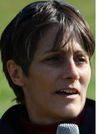Oct 25, 2012When orienteering athletes start their competition, they enter into the forest and aren't seen again by spectators until they emerge at the end of the event. That means that friends and family, eager to learn how their favorite participant is doing at navigating an unfamiliar terrain with a map and compass, have to wait to see them return and learn the details after the fact. RFID technology however, is now bringing visibility to those woodland activities.
For the 2012 North American Orienteering Championships (NOAC), held last weekend at the Delaware Water Gap National Recreational Area, in Pennsylvania, up to 26 "control points" were fitted with RFID readers and hundreds of participants were issued RFID tags. The technology was provided by New Zealand company O-lynx and German RFID solution provider Sportident.
Orienteering is a sporting event that requires athletes to carry a map to locate specific points on an unmarked course—typically in forested or other wilderness areas. Whoever can complete the course and stop at each point the fastest within his or her age, gender and experience category, is deemed the winner. The sport is popular in parts of Europe, as well as increasingly in North America.
At the North American Orienteering Championships, competitors came from around the world to find their way through courses that varied from 2.5 to 13.1 kilometers in length, based on the distance category (sprint, middle and long) and the participants’ gender and age, with each course consisting of 10 to 26 control points spread out through acres of woodland. For the past decade or so the North American club has used low-frequency 125 kHz passive RFID tags and readers to track the time at which each participant reached each point in the course, but this year for the first time the group also used wireless technology to send data back in real-time so that an announcer could update the audience as to who was reaching what point in the course.
At the beginning of the race, each participant was issued a Sportident tag that was strapped to a finger. The tag was encoded with a unique ID number linked to that participant's name in the back-end software provided by O-Lynx. They then began the race at staggered times, carrying a map and compass to help them find their way to control points. When a participant located a control point box (marked with a small flag), he or she inserted the RFID tag into a hole in the reader. The reader captured the unique ID number on the tag and then wrote the time and its own ID to the tag as well as storing that information itself. In that way the tag, with one kilobyte of memory, could collect the times it reached each point.
When the participant reached the end of the course, he or she inserted the tag into a final reader where all the read point data written to the tag was read, and printed on paper. In the meantime, the data was stored on the readers to provide a record of all the individual's times, as well as provide redundancy in the event there was a problem with one of the tags, or data was lost.
In addition, this year the group installed O-Lynx 2.4 GHz radio units at 13 of the control points, says Valerie Meyer, the NOAC's results coordinator. The Sportident reader to the O-Lynx radio device transmitted the data via a mesh network to a master controller that sent it to the O-Lynx software on the PC, explains Phillip Herries, Sportident's director. The network included several repeaters erected on hills to ensure transmission across the forested area. That real-time data—identifying who had just presented a tag at what control point—was displayed on a PC for the games announcer, who could announce to the audience just who had reached what point, and further details such as who was now in the lead, who was gaining on another participant, and who was nearing the finish line. In that way, the system provided a window into what was happening far from the audience.
With a listing of results on a digital monitor, says Herries, the participants "can be watched as their time and current placing is displayed, relevant to how other runners have tackled the same course."
The North American event included a total of about 700 participants, all of whom wore RFID tags, says Sandy Fillebrown, the NAOC's event director. The technology cost the club about $100 per reader, she says, and it has a total of about 250 that are put to use at varying times.
Prior to using RFID, she says, the group hung a pair of plastic pincers at every control point that a participant would use to punch a hole in card issued at the start of the race. Each pair of plastic pincers pricked uniquely shaped holes in a card to indicate that a point has been reached. The most advanced solution for tracking participants today, she adds, is a GPS system that tracks the movement of individuals in real-time throughout the course.
In the meantime, last week's event provided participants with more visibility than has been offered before. Overall, she says, the system worked well.


